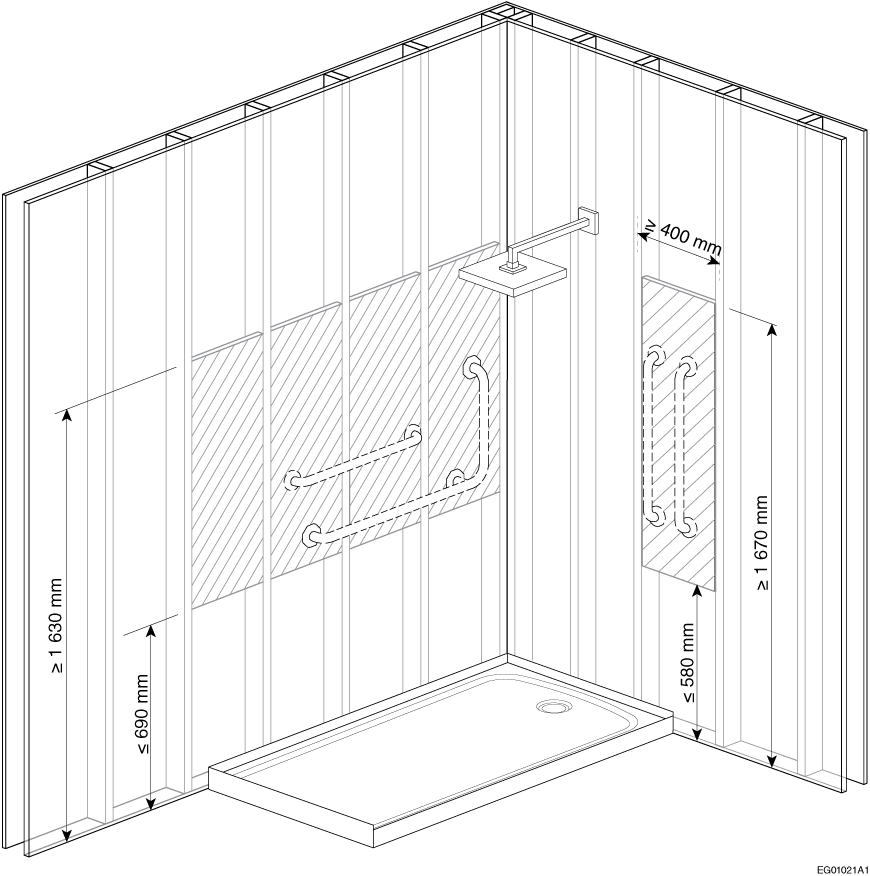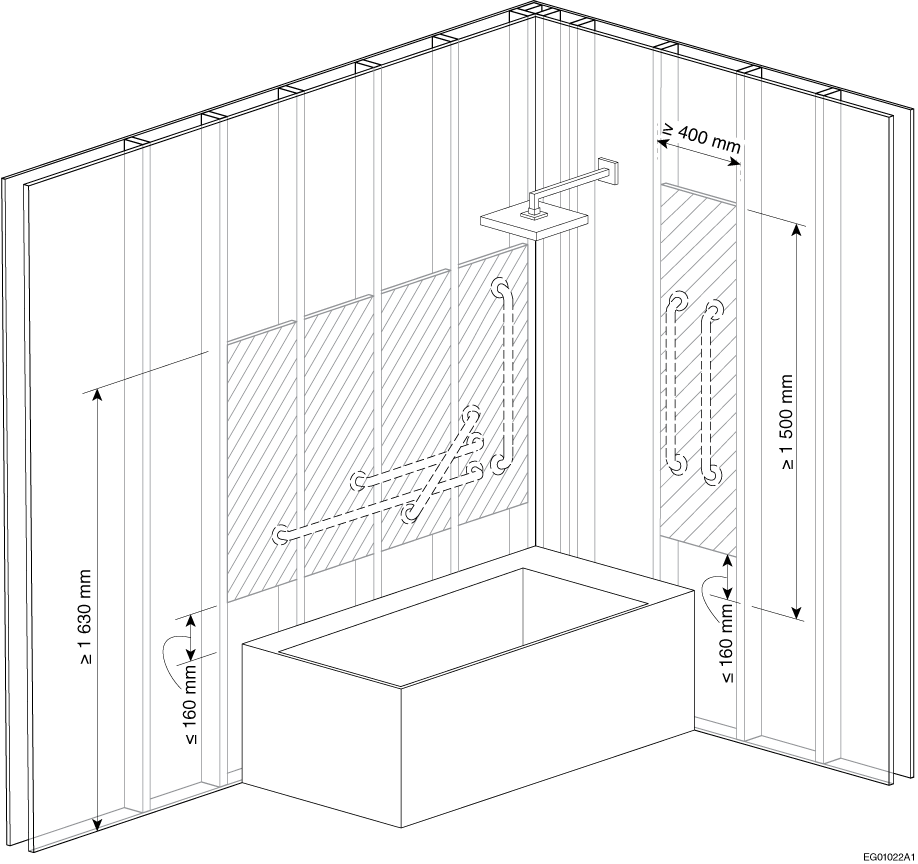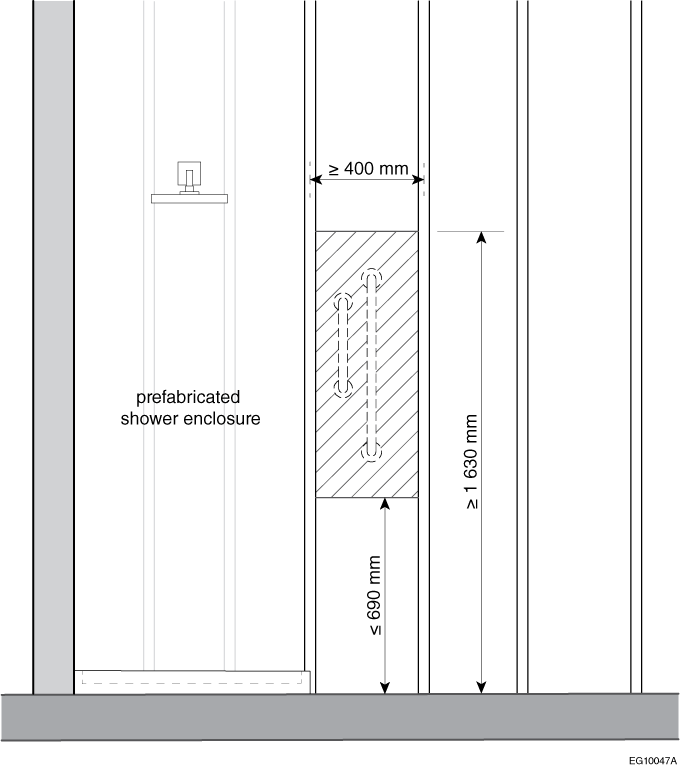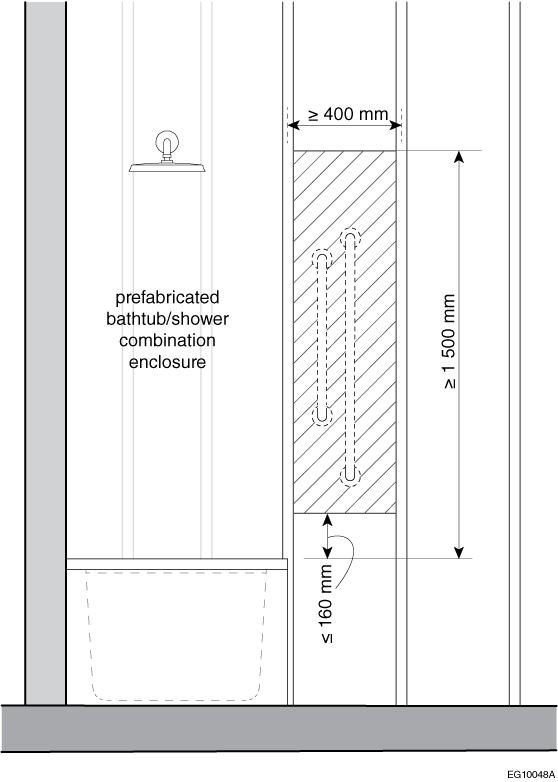General information
Problem
Approximately 10% of Canadians have a disability related to balance and walking, including 9% of Canadians aged 35 years old to 64 years old, and 25% of Canadians over 65 years old [1]. The prevalence of disabilities related to mobility increases with age, being reported in most adults over 80 years old [2]. Thus, most Canadians will need balance and mobility assistance at some point in their lives. Strategies are needed to allow Canadians to easily and affordably retrofit their homes to accommodate their evolving health status and live at home for as long as possible.
Grab bars are the most common device used to improve the safety and accessibility of Canadians with disabilities related to mobility, used by 38% of this population [1]. Grab bars are typically installed near bathtubs and showers to prevent falls for persons with and without disabilities [3]. However, the National Building Code of Canada (NBC) 2020 makes it difficult to retrofit bathrooms with grab bars, which generally need to be mounted onto studs or other reinforcement behind outer wall materials to meet the NBC requirements for structural strength. This situation causes the following two problems for occupants who wish to install grab bars:
- The range of locations where grab bars can be installed while meeting the NBC requirements for structural strength is limited because the NBC only requires studs to be spaced up to 400 mm to 600 mm apart in most interior bathrooms. This requirement makes it difficult to position grab bars in a way that allows a person with a disability related to balance or mobility to access and use the washroom facilities.
- The narrow width of the studs (often less than 40 mm) allows little room for error in positioning the grab bar to ensure that all of the mounting screws penetrate the stud to meet the structural strength requirements. Slight misalignments in the wall studs may make it impossible to install grab bars properly. Loading improperly installed grab bars may cause the bar to detach from the wall and cause a fall or injury to users.
Justification
This proposed change introduces a requirement to install reinforcement to stud walls around the bathtub and shower in washrooms to support the potential installation of grab bars and similar fixtures by homeowners or other occupants. By reinforcing stud walls in washrooms, this proposed change addresses the following major barriers to grab bar installations:
- Increasing the range of locations where grab bars can be installed while still meeting NBC requirements for structural strength would allow an occupant to customize the location of grab bars to meet the occupant’s individual needs for balance and mobility. This proposed change would limit the probability that users with a disability related to mobility would be unable to install a grab bar in a position that allows them to safely and easily use washroom facilities.
- Facilitating the proper installation of grab bars would make them more likely to meet the NBC requirements for structural strength. This proposed change would limit the probability of grab bars detaching from walls during use and resulting in falls or injuries to users.
The proposed change expands on existing requirements for reinforcement to washroom walls in Nova Scotia, Ontario, British Columbia and Alberta by prescribing the area around the wall where reinforcement is required, similar to the approach already adopted in Quebec.
A central element of this proposed change addresses the need for flexibility in the locations on the wall where grab bars can be installed and customized to individual needs, while minimizing the demands on the occupant installing grab bars in the future to be aware of the exact location of the wall that is reinforced. To that end, this proposed change expands on existing requirements for reinforcement to washroom walls in most provinces and territories (except for Quebec) by prescribing a larger area of wall coverage to support common applications of grab bars in private dwellings (which go beyond bar configurations to support wheelchair or bench transfers in public spaces). Also, this proposed change better addresses the vast range of washroom configurations in dwellings, where it is not always physically possible to install grab bars in the same locations recommended for public spaces because the washroom is too small. The proposed range includes:
- A larger area of side wall coverage in showers to address the need for:
- lower installations (690 mm to 850 mm) to support horizontal bars for children and initiating rising from a shower seat, as well as diagonal and vertical bars for continued balance while rising or standing [4],
- mid-range installations (850 mm to 1 020 mm above the floor) to support horizontal or diagonal bars that can be optimized to user height for balance while standing in the shower [5][6], and
- higher installations (1 020 mm to 1 630 mm above the floor) to support the upper end of vertical and diagonal bars for balance control in the shower [4] and for compatibility with the NBC 2020 requirements for accessible showers.
- In addition to the proposed area for coverage in showers, bathtub coverage between 160 mm above the rim of the tub to 1 620 mm above the floor to permit the installation of horizontal and diagonal grab bars to support transferring between the base of the bathtub to a standing position [7][8], and for compatibility with the NBC grab bar requirements for accessible bathtubs (Subclause 3.8.3.18.(1)(f)(iv), stipulating a horizontal bar between 180 mm to 280 mm above the rim).
- Coverage on the walls for entering and exiting bathtubs in locations compatible with common accessibility requirements for grab bars (e.g., CSA B651, “Accessible design for the built environment,” and NBC Article 3.8.3.18.), and demonstrated to reduce fall risk during bathtub exits [3].
The proposed change includes exemptions for:
- showers, bathtubs and bathtub/shower combinations that have prefabricated walls, on the basis that drilling through the walls of these products to install grab bars would generally void the product warranty, and that people who are replacing their prefabricated enclosures with tiled walls around their bathtub or shower would have the opportunity to install reinforcement and/or grab bars at that point, and
- bathtubs not abutting adjacent walls (e.g., sunken, drop-in and free-standing bathtubs), as mentioned in an explanatory Note, on the basis that stanchions are more common technologies for supporting bathtub transfers in these contexts, and these types of bathtubs tend to be located too far from the wall for the practical use of grab bars.
This proposed change should be considered in conjunction with the following other proposed changes:
- PCF 2031, which prescribes the minimum area for reinforcing walls around the toilet (i.e., water closet) for the present or future installation of grab bars, and
- PCF 2030, which stipulates a performance requirement for the structural strength of the reinforcement material and methods of attaching to the studs, alongside compliance options for different types of material.
References
(1) Statistics Canada. (2020). Canadians with a mobility disability. https://www150.statcan.gc.ca/n1/pub/11-627-m/11-627-m2020085-eng.htm
(2) Musich, S., Wang, S. S., Ruiz, J., Hawkins, K., and Wicker, E. (2018). The impact of mobility limitations on health outcomes among older adults. Geriatric nursing, 39(2), 162–169.
(3) Levine, I. C., Montgomery, R. E., and Novak, A. C. (2021). Grab bar use influences fall hazard during bathtub exit. Human factors. https://journals.sagepub.com/doi/abs/10.1177/00187208211059860
(4) King, E. C., & Novak, A. C. (2017). Effect of bathroom aids and age on balance control during bathing transfers. The American Journal of Occupational Therapy, 71(6), 1–9.
(5) Nirmalanathan, K. (2019). Influence of Grab Bar Orientation on Balance Recovery Following a Perturbation During Bathtub Exits. University of Toronto (Canada).
(6) Maki, B. E., Bartlett, S. A., & Fernie, G. R. (1984). Influence of stairway handrail height on the ability to generate stabilizing forces and moments. Human Factors, 26(6), 705–714.
(7) Sveistrup, H., Lockett, D., Edwards, N., & Aminzadeh, F. (2006). Evaluation of bath grab bar placement for older adults. Technology and Disability, 18(2), 45–55.
(8) Aminzadeh, F., Edwards, N., Lockett, D., & Nair, R. C. (2000). Utilization of bathroom safety devices, patterns of bathing and toileting, and bathroom falls in a sample of community living older adults. Technology and Disability, 13(2), 95–103.
PROPOSED CHANGE
[3.8.] 3.8. Accessibility
[3.8.1.] 3.8.1. Scope
[3.8.1.1.] 3.8.1.1.Scope
[3.8.2.] 3.8.2. Application
[3.8.2.1.] 3.8.2.1.Exceptions
[3.8.2.2.] 3.8.2.2.Entrances
[3.8.2.3.] 3.8.2.3.Areas Requiring a Barrier-Free Path of Travel
[3.8.2.4.] 3.8.2.4.Access to Storeys Served by Escalators and Moving Walks
[3.8.2.5.] 3.8.2.5.Exterior Barrier-Free Paths of Travel to Building Entrances and Exterior Passenger-Loading Zones
[3.8.2.6.] 3.8.2.6.Controls
[3.8.2.7.] 3.8.2.7.Power Door Operators
[3.8.2.8.] 3.8.2.8.Plumbing Facilities
[3.8.2.9.] 3.8.2.9.Assistive Listening Systems
[3.8.2.10.] 3.8.2.10.Signs and Indicators
[3.8.2.11.] 3.8.2.11.Counters
[3.8.2.12.] 3.8.2.12.Telephones
[3.8.3.] 3.8.3. Design
[3.8.3.1.] 3.8.3.1.Design Standards
[3.8.3.2.] 3.8.3.2.Barrier-Free Path of Travel
[3.8.3.3.] 3.8.3.3.Exterior Walks
[3.8.3.4.] 3.8.3.4.Exterior Passenger-Loading Zones
[3.8.3.5.] 3.8.3.5.Ramps
[3.8.3.6.] 3.8.3.6.Doorways and Doors
[3.8.3.7.] 3.8.3.7.Passenger-Elevating Devices
[3.8.3.8.] 3.8.3.8.Controls
[3.8.3.9.] 3.8.3.9.Accessible Signs
[3.8.3.10.] 3.8.3.10.Drinking Fountains
[3.8.3.11.] 3.8.3.11.Water-Bottle Filling Stations
[3.8.3.12.] 3.8.3.12.Accessible Water-Closet Stalls
[3.8.3.13.] 3.8.3.13.Universal Washrooms
[3.8.3.14.] 3.8.3.14.Water Closets
[3.8.3.15.] 3.8.3.15.Water-Closet Stalls and Urinals for Persons with Limited Mobility
[3.8.3.16.] 3.8.3.16.Lavatories and Mirrors
[3.8.3.17.] 3.8.3.17.Showers
[3.8.3.18.] 3.8.3.18.Accessible Bathtubs
[3.8.3.19.] 3.8.3.19.Assistive Listening Systems
[3.8.3.20.] 3.8.3.20.Counters
[3.8.3.21.] 3.8.3.21.Telephones
[3.8.3.22.] 3.8.3.22.Spaces in Seating Area
[3.8.4.] -- Dwelling Units
[3.8.4.1.] ---Entrance Doorway Width
[3.8.4.2.] ---Walls around Water Closets
[3.8.4.3.] ---Walls around Showers and Bathtubs
Note A-3.8.4.3.(2) and (4) Reinforcement of Walls around Showers, Bathtubs and Bathtub/Shower Combinations.
Example of an acceptable configuration for the reinforcement of the side wall and entrance wall(1) of a shower

Example of an acceptable configuration for the reinforcement of the side wall and entrance wall(1) of a bathtub or bathtub/shower combination

Note A-3.8.4.3.(3) Application of Sentence 3.8.4.3.(3) to Bathtubs and Bathtub/Shower Combinations Not Abutting Walls.
Note A-3.8.4.3.(5) Exceptions for Showers, Bathtubs and Bathtub/Shower Combinations Provided with Prefabricated Enclosures.
Example of an acceptable configuration for the reinforcement of the entrance wall of a shower provided with a prefabricated enclosure

Example of an acceptable configuration for the reinforcement of the entrance wall of a bathtub or bathtub/shower combination provided with a prefabricated enclosure

Impact analysis
Impact on Flexibility of Design
This proposed change is expected to improve design flexibility for homeowners by increasing the range of locations where grab bars can be installed around bathtubs and showers to meet individual accessibility and safety needs while still meeting the NBC requirements for structural strength.
Financial Impact
The financial impact of the proposed change depends on whether the jurisdiction already requires the reinforcement of washroom walls in some form, though in general the proposed change would increase the initial cost of construction. The cost estimates below are based on the prescriptive options described in PCF 2030. For designers who choose to use the performance-based option and demonstrate that their material, thickness and attachment combination would allow the installation of grab bars to meet the NBC requirements for structural strength, the costs would be different.
Table 1 presents a breakdown of the cost estimates. The key assumptions are as follows:
- The length of the side wall is 1 600 mm; costs differ based on the length of the wall.
- For the walls along the shower or bathtub entry or exit:
- the required area is assumed to span between two studs, though a larger area of coverage (1 200 mm wide × 2 400 mm high / 4 ft. wide × 8 ft. high) is assumed for the sheathing option, and
- an additional stud would be needed to provide framing on either side of the shower entrance or bathtub rim for the blocking option.
- For sheathing, the cost estimates assume that two 12.7 mm (0.5 in.) thick panels of plywood are fastened together with adhesive to achieve the required 25.4 mm (1 in.) thickness.
- For bathtubs, the height of the rim is 355 mm (15 in.) above the floor. This is a conservative estimate; for higher tubs, the required area for wall coverage would be less.
| Wall of Interest | Cost of Solid Lumber | Cost of Sheathing |
|---|---|---|
|
Side wall - shower |
~$110–$120 (assume a 4 × 4 grid of 2 × 10s) |
~$240–$260 (assume 4 panels of 1 200 mm × 2 400 mm (4 ft. × 8 ft.) plywood @ 12.7 mm thick, fastened together to create 2 panels of 1 200 mm × 2 400 mm plywood @ 25.4 mm thick covering an area ≤ 2 400 mm × 2 400 mm; costs will be higher where the side wall is longer or higher) |
|
Side wall - bathtub or bathtub/shower combination |
~$135–$145 (assume a 4 × 4 grid of 2 × 12) |
~$240–$260 (same assumption as above) |
|
Entrance walls - shower |
~$35–$45 per wall (assume a 4 x 1 grid of 2 × 12s + 1 additional stud on each side of the shower) ~$70–$90 total per shower, assuming that two walls are present for reinforcing |
~$120–$130 per wall (assume 2 panels of 1 200 mm × 2 400 mm plywood @ 12.7 mm thick fastened together to cover an area of 1 200 mm × 2 400 mm) + additional material, labour, overhead and profit to make the entire wall flush with the reinforced area ~$240–$260 total per shower, assuming that two walls are present to be reinforced
|
|
Entrance walls - bathtub and bathtub/shower combination |
~$45–$55 per wall (assume a 5 × 1 grid of 2 × 12s + 1 additional stud on each side of the shower) ~$90–$110 total per shower, assuming that two walls are present for reinforcing |
~$120–$130 per wall (assume 2 panels of 1 200 mm x 2 400 mm plywood @ 12.7 mm thick fastened together to cover an area of 1 200 mm x 2 400 mm) + additional material, labour, overhead and profit to make the entire wall flush with the reinforced area ~$240–$260 total per shower, assuming that two walls are present for reinforcing |
Where washroom walls beside showers or bathtubs are shorter, the cost will be lower to reflect that a smaller wall area is being reinforced. The material costs may also be lower in situations where spare material is available on construction sites. These cost estimates are based on RSMeans data for the Greater Ottawa Region from 2022 and account for materials, labour, overhead and profit.
- solid lumber (2 × 10) with pneumatic nails: $18.27/linear m ($5.57/linear ft.)
- solid lumber (2 × 12) with pneumatic nails: $21.72/linear m ($6.62/linear ft.)
- plywood (12.7 mm thick) with screws: $20.77/m2 ($1.93/ft.2)
- extra stud for framing around the shower and bathtub entry (2 × 4 × 96): ~$5.00
The proposed change applies to new constructions. For dwelling units where grab bars are to be installed in the future, the proposed change is expected to result in cost savings relative to the current NBC requirements for the following two reasons:
- To retrofit washroom walls with reinforcement that permit grab bar installation in any location, components of the existing wall would potentially need to be removed and replaced. Thus, the costs would include not only the cost of the reinforcement, but also the cost of replacing the other wall components (e.g., drywall, where applicable).
- To retrofit a washroom with grab bars, many older adults rely on professional contractors to ensure that the bars are correctly mounted to the studs of the wall. This process can cost over $1 000, depending on the number of bars being installed. This discourages many older adults from installing grab bars when they would like to [9]. By reducing the complexity of grab bar installation, certain homeowners may be able to install these grab bars without requiring a professional contractor. For homeowners who hire a professional contractor, the presence of reinforcement will still reduce the complexity (and potentially the cost) of grab bar installation.
Impact on Spatial Requirements for Washrooms
The proposed change is not expected to impact the spatial requirements for washrooms where solid lumber is used as the material. In contexts where sheathing is installed between wall studs and drywall, the available space in the washroom will be reduced by 25.4 mm (1 in.) per wall face that is reinforced.
Impact on Accessibility
The proposed change does not impact immediate-term accessibility because it does not require individuals to install grab bars. However, over the life cycle of a dwelling unit, the proposed change would provide more flexibility for individuals who retrofit their washrooms with grab bars and similar fixtures in locations that improve the safety of mobility for a diverse range of user anthropometries and needs. At present, grab bars only meet the NBC requirements for structural strength when mounted to stud walls, which are typically spaced 400 mm apart and can be difficult to locate. The proposed change would allow grab bars or similar balance aids to be installed at a greater range of locations on washroom walls, while still providing adequate structural strength. This will make it easier to customize the grab bar location to user anthropometry and common movement tasks.
Nearly 25% of Canadians over 65 years old, and most people over 80 years old, report experiencing a disability related to mobility [1]. Furthermore, the Canadian population over the age of 85 is expected to triple in the next 30 years [10]. Together, these factors suggest that most Canadians will need to adapt their dwelling units at some point to meet their evolving needs and that the demand for adaptable housing will increase. The proposed change helps to address this demand by making it easier for individuals to install grab bars, which are the most common assistive device used by persons with disabilities related to mobility.
Impact on Safety
The proposed change does not affect immediate-term safety or health because it does not require grab bars or any other fall-prevention device to be installed. However, for persons who decide to install grab bars in washrooms, the proposed change makes it easier and less expensive to install grab bars in accordance with the NBC requirements for structural strength.
Impact on the Provinces and Territories
The impact of the proposed change on specific provinces and territories depends on the current application of accessibility requirements to different types of dwelling units. Nova Scotia and Ontario already require reinforcement of the washroom walls around the water closet in all dwellings to support the future installation of grab bars that comply with the NBC requirements for structural strength, while Quebec requires reinforcement of washroom walls in individual units in multi-unit residential buildings without an explicit requirement that addresses structural strength. While the proposed change prescribes the reinforcement of a larger wall area relative to provisions in Nova Scotia and Ontario, prescriptive requirements on the location of reinforcement and its design (PCF 2030) may reduce the costs of design that otherwise needs to demonstrate that the reinforcement meets the NBC performance-based requirements for structural strength supporting grab bars.
The impact of this proposed change would be the greatest in all other provinces and territories where requirements for the reinforcement of washroom walls are not yet in place, both in terms of initial cost of construction and increased flexibility in where grab bars can be safely installed in washrooms. Harmonizing requirements across the country may help to stimulate innovation in construction methods and materials to lower the cost of this proposed change.
References
(1) Statistics Canada. (2020). Canadians with a mobility disability. https://www150.statcan.gc.ca/n1/pub/11-627-m/11-627-m2020085-eng.htm
(2) Musich, S., Wang, S. S., Ruiz, J., Hawkins, K., & Wicker, E. (2018). The impact of mobility limitations on health outcomes among older adults. Geriatric nursing, 39(2), 162-169.
(3) Levine, I. C., Montgomery, R. E., and Novak, A. C. (2021). Grab bar use influences fall hazard during bathtub exit. Human factors. https://journals.sagepub.com/doi/abs/10.1177/00187208211059860
(4) King, E. C., & Novak, A. C. (2017). Effect of bathroom aids and age on balance control during bathing transfers. The American Journal of Occupational Therapy, 71(6), 1–9.
(5) Nirmalanathan, K. (2019). Influence of Grab Bar Orientation on Balance Recovery Following a Perturbation During Bathtub Exits. University of Toronto (Canada).
(6) Maki, B. E., Bartlett, S. A., & Fernie, G. R. (1984). Influence of stairway handrail height on the ability to generate stabilizing forces and moments. Human Factors, 26(6), 705–714.
(7) Sveistrup, H., Lockett, D., Edwards, N., & Aminzadeh, F. (2006). Evaluation of bath grab bar placement for older adults. Technology and Disability, 18(2), 45–55.
(8) Aminzadeh, F., Edwards, N., Lockett, D., & Nair, R. C. (2000). Utilization of bathroom safety devices, patterns of bathing and toileting, and bathroom falls in a sample of community living older adults. Technology and Disability, 13(2), 95–103.
(9) Wiseman, J. M., Stamper, D. S., Sheridan, E., Caterino, J. M., Quatman-Yates, C. C., & Quatman, C. E. (2021). Barriers to the initiation of home modifications for older adults for fall prevention. Geriatric orthopaedic surgery & rehabilitation, 12.
(10) Statistics Canada. (2022). Population Projections for Canada (2021 to 2068), Provinces and Territories (2021 to 2043).
https://www150.statcan.gc.ca/n1/pub/91-520-x/91-520-x2022001-eng.htm.
Enforcement implications
This proposed change could be enforced to some extent by using existing methods in Nova Scotia, Ontario and Quebec, where changes related to the reinforcement of walls in washrooms have already been implemented in the provincial building codes. As the wall reinforcement is not visible after construction is complete, designers or builders would need to provide information about the location of reinforced walls with other detailed plans of the building. Details on the number and nature of fasteners used to attach the reinforcement to the stud wall would also be needed in contexts where the prescriptive options for compliance are used.
Authorities having jurisdiction would need to become familiar with the new requirements (including the expanded range where the reinforcement of washroom walls is required and the specifications for materials and thicknesses of the reinforcement) and techniques for evaluating compliance.
Who is affected
Homeowners and occupants would be able to install grab bars in a larger range of locations on washroom walls while still meeting the NBC requirements for structural strength.
Architects and designers would need to be aware of and potentially modify the design of dwelling units based on this proposed change.
Builders would need to incorporate this proposed change into the construction process for dwelling units.
Authorities having jurisdiction would need to become aware of this proposed change.
OBJECTIVE-BASED ANALYSIS OF NEW OR CHANGED PROVISIONS
- Date modified:
